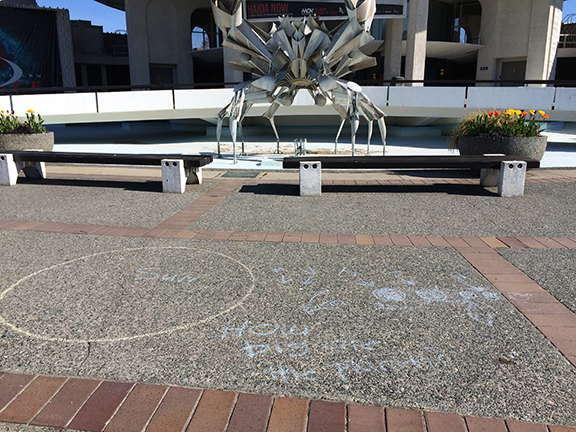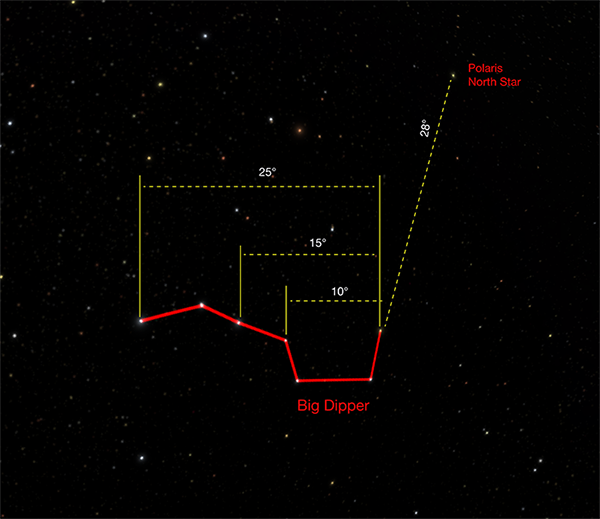With the beautiful spring weather, I’ve been noticing chalk art springing up on sidewalks. Inspired by some of the art in my neighbourhood, I used my sidewalk to explore the scale of our solar system.
Here’s what it looks like.

If you’d like to try this on your sidewalk here are some tips.
As I was measuring the distances for my sidewalk solar system, I began to wonder about how astronomers do this. They would need something more than a tape measure!
I asked our astronomer Rachel Wang about this and she told me that astronomers have different ways to measure distances depending on how far away the object is. She pointed me to this great short video from TedED about how astronomers measure distance.
Don’t get overwhelmed by the very complicated ways astronomers measure distances; there is one more tool you can use to measure distances in the night sky—your hand! Here’s how it works.
Astronomers measure the distance between objects in the night sky by degrees. There are 360 degrees in a circle and the night sky represents half a circle or 180 degrees. If you looked straight up you are looking at 90 degrees. To measure degrees in the night sky all you need to do is stretch out your hand at arm’s length and do the following:
• stretch your fingers wide so your thumb and little finger are far apart
• the span between your thumb and little finger is about 25 degrees
• the span between your index finger and little finger is about 15 degrees
• clench your fist—the width of your fist is about 10 degrees
• hold your three middle fingers together—the width is about 5 degrees
• hold up your little finger—the width is about 1 degree
On the next clear night test this out. Go outside and find the big dipper. Use this diagram and try measuring the distances between the stars

I hope these activities have inspired you to discover more about the scale of the universe and our place in it. We’ve pulled together a couple of playlists with some of our favourite web resources to help you discover more. Go through the playlist at your own pace. Here’s how we suggest you start:
Astronomer’s playlist
Time
Junior Astronaut Activities
5 mins
Get inspired by watching the Knowledge Network episode Scaling the Universe. You have to sign up and log in but it is worth it!
What surprises you the most about the size of objects in our universe?
20 mins
Discover more about the sizes of the objects through the Scale of the Universe online activity. Then watch the Powers of Ten video to get a sense of distance between objects.
Choose something small and something large to learn more about. What would you like to know more about?
90 mins
Make your own scale models of our solar system.
Earth as a Peppercorn: This activity show how big objects in our solar system are…if Earth was the size of a peppercorn.
Solar System Scroll: This activity shows the distance between objects in our solar system
How do the activities change your understanding of the scale of our solar system?
60 mins
Share what you’ve learned with your neighbours.
Use the Sidewalk Solar System activity to make scale drawings of our solar system on your sidewalk.
If you are really keen, draw a larger scale solar system. Use the Build a Solar System website to help you with the math.
Can you imagine travelling to another planet in our solar system? What about travelling to another solar system?
Time
Senior Astronaut Activities
5 mins
Get inspired by watching the Knowledge Network episode Scaling the Universe. You have to sign up and log in but it is worth it!
What surprises you the most about the size of objects in our universe?
60 mins
Discover more about how astronomers measure distances in the universe. Watch the video How Do We Measure Distance in Space? and then read more in the Digging Deeper section.
90 mins
Make your own scale models of our solar system.
Earth as a Peppercorn: This activity show how big objects in our solar system are…if Earth was the size of a peppercorn.
Solar System Scroll: This activity shows the distance between objects in our solar system
How do the activities change your understanding of the scale of our solar system?
60 mins
Share what you’ve learned with your neighbours.
Use the Sidewalk Solar System activity to make scale drawings of our solar system on your sidewalk.
If you are really keen, draw a larger scale solar system. Use the Build a Solar System website to help you with the math.
Can you imagine travelling to another planet in our solar system? What about travelling to another solar system?
3 hrs
Now really challenge yourself and learn more about how astronomers use standard candles to measure the universe, with the Street Lights as Standard Candles activity. This activity will give you a chance to sharpen your math skills and analyze the brightness of streetlights in your neighbourhood. (Note: this activity is for youth 14+.)
How do you think astronomers would use the skills you use in this activity?

